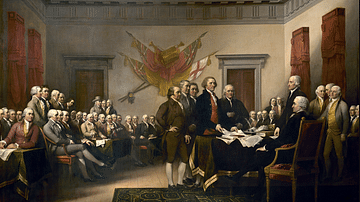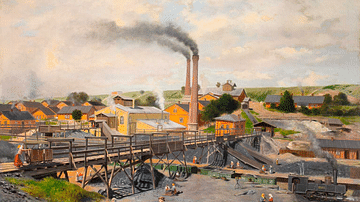The British Industrial Revolution (1760-1840) witnessed a great number of technical innovations, such as steam-powered machines, which resulted in new working practices, which in turn brought many social changes. More women and children worked than ever before, for the first time more people lived in towns and cities than in the countryside, people married younger and had more children, and people's diet improved. The workforce become much less skilled than previously, and many workplaces became unhealthy and dangerous. Cities suffered from pollution, poor sanitation, and crime. The urban middle class expanded, but there was still a wide and unbridgeable gap between the poor, the majority of whom were now unskilled labourers, and the rich, who were no longer measured by the land they owned but by their capital and possessions.
Urbanisation
The population of Britain rose dramatically in the 18th century, so much so that a nationwide census was conducted for the first time in 1801. The census was repeated every decade thereafter and showed interesting results. Between 1750 and 1851, Britain's population rose from 6 million to 21 million. London's population grew from 959,000 in 1801 to 3,254,000 in 1871. The population of Manchester in 1801 was 75,000 but 351,000 in 1871. Other cities witnessed similar growth. The 1851 census revealed that, for the first time, more people were living in towns and cities than in the countryside.
More young people meeting each other in a more confined urban setting meant marriages happened earlier, and the birth rate went up compared to societies in rural areas (which did rise, too, but to a lesser degree). For example, "In urban Lancashire in 1800, 40 per cent of 17-30-year-olds were married, compared to 19 per cent in rural Lancashire. In rural Britain, the average age of marriage was 27, in most industrial areas 24, and in mining areas about 20" (Shelley, 98).
Urbanisation did not mean there was no community spirit in towns and cities. Very often people living in the same street pulled together in a time of crisis. Communities around mines and textile mills were particularly close-knit with everyone being involved in the same profession and with a community spirit and pride fostered by such activities as a colliery or mill band. Workers also got together to form clubs to save up for an annual outing, usually to the seaside.
Life became cramped in the cities that had grown up around factories and coalfields. Many families were obliged to share the same cheaply-built home. "In Liverpool in the 1840s, 40,000 people were living in cellars, with an average of six people per cellar" (Armstrong, 188). Pollution became a serious problem in many places. Poor sanitation – few streets had running water or drains, and non-flushing toilets were often shared between households – led to the spread of diseases. In 1837, 1839, and 1847, there were typhus epidemics. In 1831 and 1849, there were cholera epidemics. Life expectancy rose because of better diet and new vaccinations, but infant mortality could be high in some periods, sometimes over 50% for the under-fives. Not until the 1848 Public Health Act did governments even begin to assume responsibility for improving sanitation, and even then local health boards were slow to form in reality. Another effect of urbanisation was the rise in petty crime. Criminals were now more confident of escaping detection in the ever-increasing anonymity of life in the cities.

Cities became concentrations of the poor, surviving off the charity of those more fortunate. Children roamed the streets begging. Children without homes or a job, if they were boys, were often trained to become a Shoe Black, that is someone who shined shoes in the street. These paupers were given this opportunity by charitable organisations so that they would not have to go to the infamous workhouse. The workhouse was brought into existence in 1834 with the Poor Law Amendment Act. The workhouse was deliberately intended to be such an awful place that it did little more than keep its male, female, and child inhabitants alive, in the belief that any more charity than that would simply encourage the poor not to bother looking for paid work. The workhouse involved what its name suggests – work, but it was tedious work indeed, typically unpleasant and repetitive tasks like crushing bones to make glue or cleaning the workhouse itself. Despite all the problems, urbanisation continued so that by 1880 only 20% of Britain's population lived in rural areas.
Working Life
Men
Male workers had opportunities as never before during the Industrial Revolution with the boom in mining, mechanised factories, shipbuilding, and the railways with their train stations and construction projects. Many of these jobs were unskilled, though, and those men who had skills like carpentry, textile weaving, and horse handling were, in many cases, replaced by machines. Men also faced much more competition from women, who were significantly cheaper in terms of wages. Those men who did find work secured a more stable wage than previously, but mechanised workplaces could be dangerous, and the work was often dull and repetitive. The factory system, where workers concentrated only on a specific part of the production process, meant that workers had little sense of achievement in the finished article as they might have done in the old domestic system where a worker produced a finished article.
Trade unions were established to protect workers' rights, but these were banned by law between 1799 and 1824. Even in the 1830s, many employers insisted that new hires sign a statement promising they were not and would not become members of a trade union. The more successful unions were those representing more skilled workers like engineers who could afford to contribute collectively so that their union had full-time workers to further the interests of its members. In this period, trade unions did not represent women or children.






A Gallery of 30 Industrial Revolution Inventions
Women
Very often, women performed the same tasks as men in the workplace, since they were cheaper and few machines needed great physical strength to operate. Most women in factories were under 30 years of age, and the majority of these were teenagers. "A British survey undertaken in 1818 found that women comprised a little over half of the workers in cotton textiles" (Horn, 57). In Scottish factories, the figure was even higher. Further, in Manchester, for example, "the highest paid female factory worker made a quarter of what the highest paid male laborer earned" (Horn, 59).
In the mines, women were employed to carry heavy baskets of coal from the face to carts for transportation, which usually involved walking through water all day. Only the arrival of the 1842 Mines Act brought the prohibition of the employment of women, girls, and boys under 10 years of age from working underground. In the short term, many women lost their jobs, and families with only daughters suffered severe financial hardship as a result of these reforms.
More positively, during the Industrial Revolution, the increased ability of women to find employment meant that they had more independence than had been the case in more traditional rural communities. Young women could be financially independent of their parents earlier and, given the increased social contact, be more selective in their choice of husband (as could men, of course). In addition, by the 1850s, "married women were also slightly more likely to have children and to minimize the spacing between births" (Horn, 5).
Children
Children worked the same 12-hour shifts that adults did but received a much lower pay (80% less than a male and 50% less than a female worker). Children, often as young as 5 but on average from 8 years old, had to perform specific tasks that adults could not, like hauling coal through narrow mine shafts or climbing under machines in factories to collect cotton waste. From 1800 to 1850, children composed between 20-50% of the mining workforce. In factories, children made up around one-third of the British workforce.
Children were either sent directly by their parents or found work on their own. There was also a system similar to indenture where parents received money from their parish in return for apprenticing their children to a factory owner. The practice was common, and it was not until 1816 that a limit was put on how far away the children were required to work – 64 km (40 mi).
In agriculture, children worked as they always had done, tending livestock and doing any menial task they were physically capable of. A development was the use of children in agricultural gangs, sent by their parish to perform seasonal tasks like helping with the harvest.
Education
The education of many children was replaced by a working day, a choice often made by parents to supplement a meagre family income. There were some rudimentary schools such as village affairs, local Sunday Schools, and (only from 1844) the Ragged Schools which focused on the three Rs: reading, writing, and arithmetic. Even the cheapest schools cost one penny a day, which was not an insignificant burden on a working family. The schoolteachers were of varying quality, too, and the classroom was usually overcrowded as the teacher's only income was the fee from parents and so they were tempted to enroll as many pupils as space allowed.
Some employers did offer education to their child and adult workers to learn to read and write. Nevertheless, education certainly took a back seat to work: "at least half of nominally school-age children worked full-time during the industrial revolution" (Horn, 57). Compulsory education for 5-to-12-year-olds and the institutions necessary to provide it would not come along until the 1870s. Literacy rates did improve in the 19th century, a development helped by the availability of cheap books made possible by economies of scale from papermaking machines and printing presses. The ability to write allowed people to take advantage of the cheap penny post system from 1840. Reading was also encouraged by the availability of cheap daily newspapers in the latter part of the 19th century.
The Lower, Middle, & Upper Classes
For the rich and powerful, land ownership, just as it always had been, remained a defining characteristic of society's elite. By 1876, a staggering 95% of the population did not own any land so, if anything, this group of great landowners became more concentrated than ever. However, there was another defining characteristic of the elite that joined land during the Industrial Revolution: capital. The very wealthy remained wealthy by investing in businesses directly, funding start-ups and inventors with loans in return for a future share of any profits, and buying shares in canal, railway, and shipbuilding companies. Private banks were a feature of a new and more prominent financial sector that helped those with money earn more of it.
Below the landowners and wealthy capitalist investors, there were the business owners who were given great power by the government's distinct lack of intervention in their affairs. Even when laws were finally passed from the 1830s that limited business owners, the consequent restrictions on working hours and health and safety regulations were rarely enforced due to a chronic lack of inspectors. There was no minimum wage, salaries were not related to inflation, and employees faced the ever-present threat of instant dismissal. In short, owners became richer while workers worked harder than ever and yet became relatively poorer.
The gulf between those at the bottom and the top widened. Factory workers, for example, had few transferable skills, and so they were stuck at their level of work. In the past, a handweaver might have saved, perhaps over many years, to form their own business with their own employees, but that method of climbing the social ladder now became much more difficult to access. To compete with larger factories, a serious investment in machinery was required that was far beyond the capabilities of the working class. Small farmers were another group that diminished as land rents increased and mechanisation favoured economies of scale so that individual farms became larger and fewer.
There was the possibility of rising through access to education, but this required an investment that few had. Apprenticeships continued to be a way for children to gain better employment than that of their parents, but again, with a hefty fee required up front and several years of unpaid work and study after, not everyone could follow this route. Some, like the multiple mill owner Robert Owen (1771-1858), did rise from the position of a lowly apprentice to become a great industrialist, but these were the exceptions that proved the rule. It is also notable that the majority of the inventors during the Industrial Revolution had received a good education, more often than not up to university level.
One's profession and social status certainly had a direct relation to one's health during the Industrial Revolution. In 1842, a doctor in Leeds, Dr Holland, collated the life expectancy of different societal groups. He found that the average life expectancy of manufacturers and the upper classes was 44 compared to 27 for shopkeepers and just 19 for labourers – lower than it had ever been.

An urban middle class grew up – around 25% of the population by 1800 – but many moved out of the increasingly cramped and dirty inner cities to new properties in the suburbs, often with a garden. Such professionals as engineers, scientists, lawyers, and so on could afford to keep servants to look after their children, keep the home tidy, and cook meals. The middle classes bought goods from new and elegant shops like the showroom of Josiah Wedgwood (1730-1795) in London. From the 1810s, new street lighting using coal gas made the streets safer to frequent at night, and so restaurants, theatres, and other entertainment establishments flourished. The middle classes, and the more prosperous shopkeepers and artisans, could afford to send their children to school or employ a private tutor.
The dawn of the Victorian period, from 1837, witnessed a strong upper- and middle-class public support for 'improving' the poorer classes by having them work harder and live 'cleaner' lives. Indeed, this often condescending moralism had begun earlier with the start of the Sunday school movement in 1780 and the Sunday School Society in 1785. There was a close link between religion and philanthropy since the majority of social reformers were Nonconformist Christians. In 1811, the National Society for Promoting the Education of the Poor was formed. This society and other similar philanthropic organisations demonstrate that there was a reaction of some sort by the middle classes, intellectuals, and artists against the indiscriminate use of labour in this new industrialised world of factories and overcrowded cities.
The standard of living did rise for most people during the Industrial Revolution, on average by around 30%, but only from the 1830s was this the experience of the lower classes. The situation of the poorest was made visible to the rest of the population through the growing interest in newspapers, pamphlets, and literature. Art such as Joshua Reynolds' The Age of Innocence (1788) and Charles Dickens' Oliver Twist (1837) helped to foster a new belief that children should be protected and poor adults should be given opportunities to better themselves or at least the lives of their children. Unfortunately, the reforms, investments, and institutions necessary to achieve this betterment would not be in place and effective until after the Industrial Revolution had passed.








